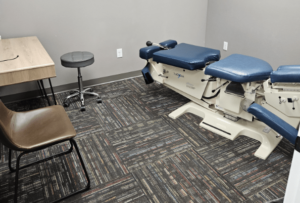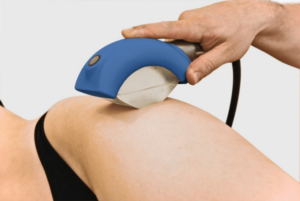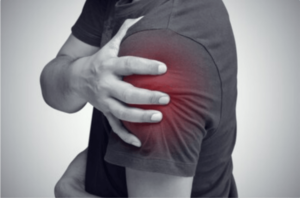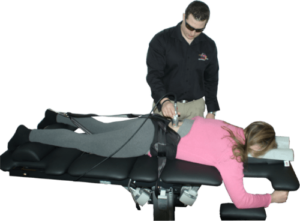Services


Your first chiropractic visit will take about 45 minutes. During this visit, Dr. Pankonin will review your medical history and provide a thorough exam. He will help you understand your exam findings and provide a treatment plan with recommendations based on the results of your examination. He may recommend chiropractic adjustments and/or a variety of cutting-edge pain relieving modalities including spinal decompression, Class 4 laser, or Acoustic Wave Compression therapy. He may also recommend X-rays or other imaging (MRI) depending on your condition. He will explain everything before treatment begins and we encourage you to ask questions at any time.
There are a few items you will want to bring to your first visit:
- List of current prescription medications and nutritional supplements
- Current radiology reports (if applicable)
We encourage you to complete the new patient paperwork online through our patient portal. When you schedule, you will be sent an email with a link to the patient portal. Here you will fill out information about your condition(s), report your past medical history, and fill out some outcome assessment forms so that we may better track your progress. If you are not able to complete your paperwork ahead of time, please arrive 15 minutes prior to your appointment and you can complete it in the office. Our friendly staff will assist as needed.
Chiropractic Care

If you’re dealing with an injury, trying to manage pain, or just want to come in for a check-up and routine correction, we can provide the chiropractic care you’re looking for. We offer a variety of adjustment techniques and therapeutic services. We have 30 years of experience helping patients feel their best.

Diversified Technique
This is the most commonly used chiropractic treatment. It involves the manipulation and adjustment of the spinal column. This technique is applied quickly and usually results in a "popping" sound as the spine and joints are reduced of motion fixations. It consists solely of hands-on adjustments; no tools or devices are used to perform the adjustment.

Cox Technique
This is a non-surgical, doctor-controlled, hands-on spinal manipulation performed with the patient lying on a special table called the Cox table. Flexion-distraction and decompression help relieve spinal pain and return patients to their desired quality of life. This is a gentle form of manipulation with no "popping" sounds. It is appropriate for all ages but is more generally used for complex spinal conditions affecting the intervertebral disc of the spine (disc herniation, degenerative disc, etc.)

Activator Technique
This is an instrument method of spinal manipulation. A hand-held device controlled by the Doctor is used to gently treat the spine.

Other services
In addition, we provide the following services:
- DOT examinations
- Sports physicals
- Therapeutic exercise instruction
- Kinesio tape application
KDT Class IV Laser Therapy

Laser light cell therapy (Photobiomodulation) is used to increase the speed, quality, and tensile strength of tissue repair. This helps to resolve inflammation and relieve pain (analgesia). The red and near-infrared light (800nm-1064nm) commonly used in PBM can be produced by infrared wavelength laser diode systems.

Treated conditions
KDT Class IV laser therapy is used to treat the following.
- TMJ dysfunction
- Neck pain
- Shoulder conditions
- Elbow conditions
- Fibromyalgia
- Low back pain
- Sciatica
- Arthritis
- Sports injuries
- Soft tissue damage
- Plantar fasciitis

Acute Conditions
Laser therapy has been shown to be very effective in treating acute conditions because of its ability to reduce edema, reduce pain and accelerate tissue repair by ATP production, endorphin release, and increasing cellular activity.

Chronic Conditions
With chronic conditions, research has shown that therapy laser can be used to help combat persistent pain and promote circulation to damaged tissues. It can be a powerful, non-pharmaceutical pain management solution that reduces pain without the side effects or dangers of medication and surgery.
Direct Contraindications (treatment should be avoided in the following cases)
- Active Cancer diagnosis or Tumors
- Over a Pacemaker
- Over pregnant abdomen or low back
- Over Reproductive organs
- Direct eye exposure
Learn more about KDT Laser Therapy
MyAct Acoustic Wave Therapy

Piezowave2 MyACT (Myofascial Acoustic Compression Therapy– MyACT) is an Acoustic Compression Therapy that uses acoustic mechanical sound waves to remodel tissue at the cellular level by addressing a large variety of conditions including, scar tissue, trigger points, fascial restrictions, tendonitis, bursitis, chronic muscle tightness, old muscle injuries and so much more.

Treated conditions
- Carpal Tunnel Syndrome
- Tennis Elbow & Golfers Elbow
- Rotator cuff tendonitis of the shoulder & Frozen Shoulder
- Trigger point therapy
- Greater Trochanteric pain syndrome
- IT band syndrome (lateral thigh pain to knee)
- Medial Tibial Stress Syndrome "Shin Splints"
- Plantar Fasciitis
- Achilles Tendinopathy
- Sacroiliac Joint Pain
- Chronic spine pain (neck, mid and lower back)
- Any soft tissue, muscle, or ligament issue

Advantages of Myofascial Acoustic Compression Therapy
MyACT is a concept that has roots going back 30 years. Extracorporeal Shockwave Therapy has been used to help break up kidney stones and gallstones. MyACT is the latest generation of this technology to be developed through scientific advances in medical research for the safe and often pain-free treatment of many musculoskeletal, fascial, and vascular conditions.
- Non-invasive
- Locates and alleviates musculoskeletal pain
- Improves mobility
- Reduces pain medication
- Improves range of motion by eliminating adhesions
- Improves circulation
- Alleviates pain and tight muscles and promotes healing

Contraindications
Contraindications to Myofascial Acoustic Compression Therapy (treatment should be avoided in the following cases)
- Infections/skin abrasions over the treatment area
- Tumor/lung/brain tissue in the area of treatment
- Pacemaker (direct treatment zone)
- Pregnancy (direct treatment zone)
- Taking blood thinners (relative, doctor and patients call, could create bruising)
- Blood clotting disorder
- Received a steroid injection within 2 weeks in the treatment area
- Neuropathic conditions affecting sensation in the treatment area
Learn more about Acoustic Wave Therapy
KDT Spinal Decompression Therapy

Spinal Decompression can reduce the size of a herniated or bulging disc but it is most important that it helps improve function and expedite healing naturally without the need for surgery, drugs, or invasive injections.

What is Spinal Decompression?
Spinal Decompression is a classification-based application of intermittent axial traction with the intention of “decompressing” a compressed disc. It is based upon positioning and specific protocols which unload the pressure from the spine and nerves which leads to an exchange of osmotic fluids that create increased disc height by re-hydration.

Advantages of Spinal Decompression
Decompression therapy can draw in good fluids (water content and nutrients) and push out bad compounds (bradykinins) which restores disc height based on your stage of spinal degeneration. It can reduce pain, improve function and range of motion and increase quality of life.

Treated conditions
- Disc herniation of the lumbar spine (lower back)
- Disc herniation of the cervical spine (neck region)
- Degenerative disc disorders
- Headaches related to cervical spine degeneration or chronic neck tension
- Spinal stenosis (early stages)
- Hip degeneration/arthritis
- Knee arthritis or chronic knee pain

Contraindications
Contraindications to spinal decompression (treatment should be avoided in the following cases)
- Pregnancy 6 months+
- Hardware
- Recent surgery less than 6 months
- Spinal cord stimulator
- Severe bone compromises
- Acute fractures
- Acute annular disc tear or sprain.
